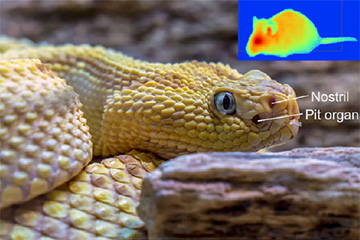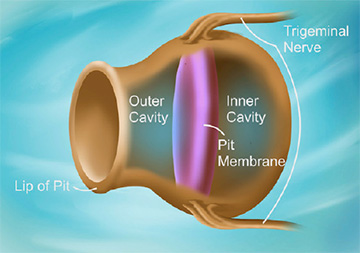
U.S. researchers have proposed a model that explains how the membrane in the pit organ of certain snakes rapidly transduces infrared radiation into an electrical signal, allowing the snake’s brain to thermally “see” its prey, even in total darkness. [Image: F. Darbaniyan et al., Matter, doi: 10.1016/j.matt.2020.09.023 (2020)]
Researchers from the University of Houston and Rutgers University, USA, have developed a model that they believe resolves a long-standing mystery: the precise biophysics of how certain animals—notably so-called pit vipers such rattlesnakes—thermally image their unfortunate prey (Matter, doi: 10.1016/j.matt.2020.09.023). In addition to clearing up a biological quandary, the team believes that the insights gained will open up new avenues toward the engineering of so-called pyroelectric materials, which convert temperature changes into electricity.
Thermal antennae
As the name implies, the heads of pit vipers include a pair of small depressions, known as the pit organ, near the snake’s nostrils. It’s long been believed that the organ—a vase-shaped body that includes a thin internal membrane—acts as a sort of antenna for infrared or thermal radiation.
Researchers have also found various clues on how the pit organ membrane might function in converting thermal signals into an image—the presence, for example, of a specific ion channel in the nerve fibers at the pit organ membrane, and the low thermal conductivity of the membrane material, which allows it to heat up rapidly. But the biophysical mystery of just how these thermal changes are transduced into electrical signals for the snake’s brain has remained unanswered.

The rattlesnake’s pit organ includes a membrane that is believed to convert changes in thermal radiation to an electrical signal to be carried to the snake’s brain. [Image: F. Darbaniyan et al., Matter, doi: 10.1016/j.matt.2020.09.023 (2020)]
Whatever its transduction mechanism, however, the pit organ is devastatingly effective. The heat “vision” of these snakes can pick up temperature differences on the order of millikelvins against a steady-state thermal background. That’s a level of sensitivity that enables pit vipers such as rattlesnakes to discern the presence—in total darkness—of an animal around 10 °C warmer than the ambient temperature in a mere half-second, at a distance of 40 cm.
Modeling soft pyroelectric materials
The team behind the new research, led by Pradeep Sharma of the University of Houston, realized that the pit organ’s extreme sensitivity to temperature changes, against a constant background, could be explained if the pit organ membrane were acting as a pyroelectric material. Such materials, which convert temperature variations into changes in electrical polarization, are already used in human-designed thermal IR detectors. The problem, however, is that such materials have tended to be hard, crystalline solids—not supple biological membranes.
To resolve the quandary, the researchers went back to the textbooks. They started by pulling together a variety of governing equations, including the first and second laws of thermodynamics, Maxwell’s equations of electrostatics, and the consitutive relations and material properties of soft matter. They then rolled those equations into an elegant framework describing the motion of a static charge carrier within a material with a given thermal expansivity and within a pre-existing electric field, when that material is subjected to a temperature change.

The research team modeled the membrane in a snake’s pit organ as a thermally expanding, thin-film material including static charge carriers. When thermal radiation strikes the material, its expansion changes the position and relative density of the charge carriers, transducing the thermal signal into an electrical impulse. [Image: F. Darbaniyan et al., Matter, doi: 10.1016/j.matt.2020.09.023 (2020)]
Next, the team applied the equations to a simple thin-film model of the snake’s pit organ membrane. Under the model, when infrared radiation strikes the membrane, thermal expansion thickens the membrane, changing the position and density of charge carriers and leading to a voltage change across the membrane. That change can then be picked up electrochemically by the nerve cells that carry the signal to the snake’s brain. The model also provided the researchers with handy mathematical terms for characterizing the thermal response time and expected current from a membrane with specific properties.
A “robust and simple” mechanism
With the model in hand, the researchers plugged in values for membrane thickness, pit organ area, membrane thermal expansivity, and other parameters from pit vipers including boa constrictors, rattlesnakes, rat snakes and pythons. They found that the model correctly predicted the specific abilities of these different snakes, established over the years in various experiments, to sense prey at particular distances, temperature-difference thresholds, infrared frequency ranges and response times.
“Our mechanism is very robust and simple,” team leader Sharma said in a press release accompanying the work. “It explains quite a lot.” The researchers are now at work on lab experiments with soft materials to validate the numerical model in physical experiments. And they believe that the fundamental finding—that a soft material that’s sufficiently temperature-sensitive and has the right thermal expansivity can be pyroelectric—affords practical opportunities to widen the palette of materials that convert heat into electricity.
“Using this model, I can confidently create an artificial soft material with pyroelectric properties,” Sharma maintains. “Of that there is no doubt.”
